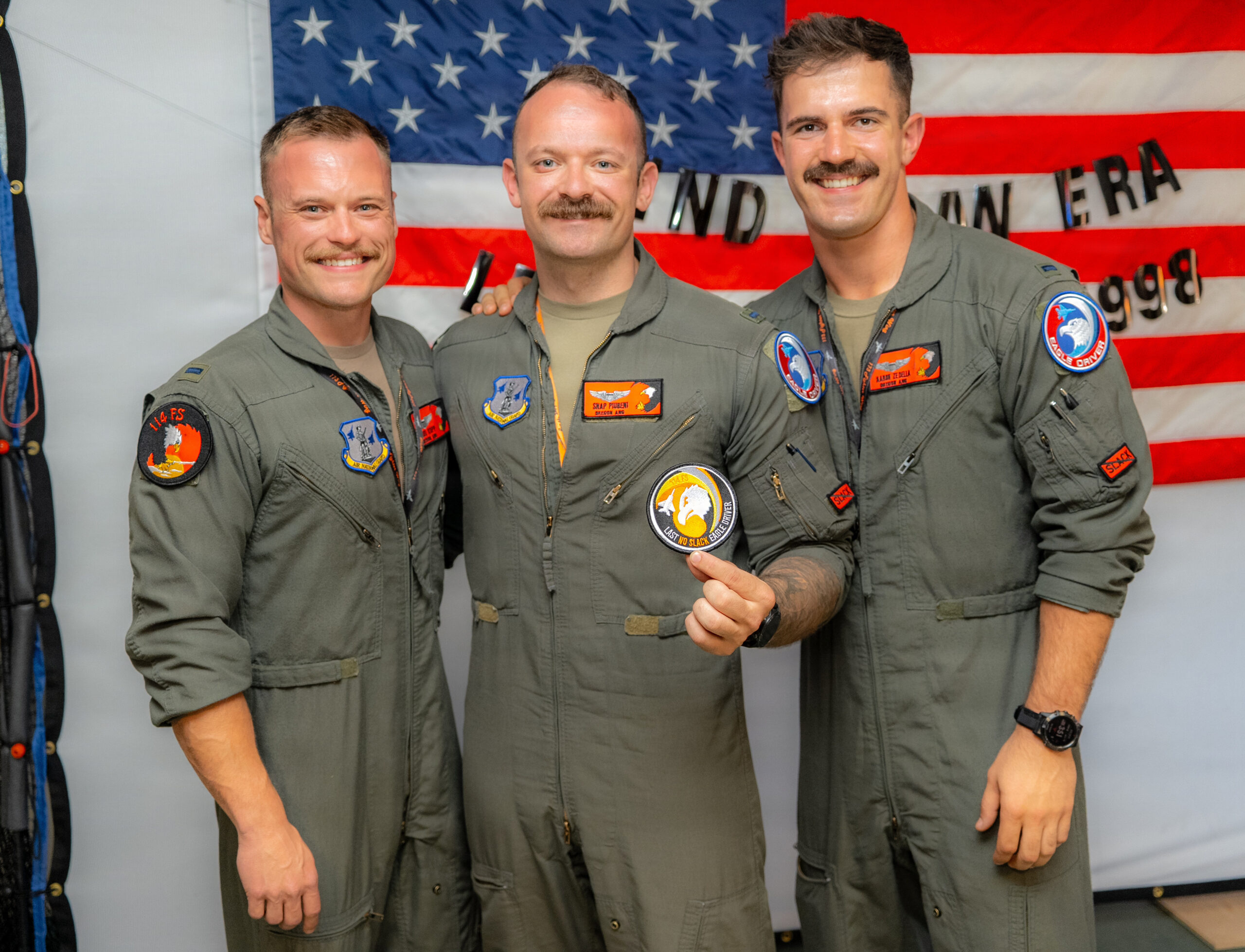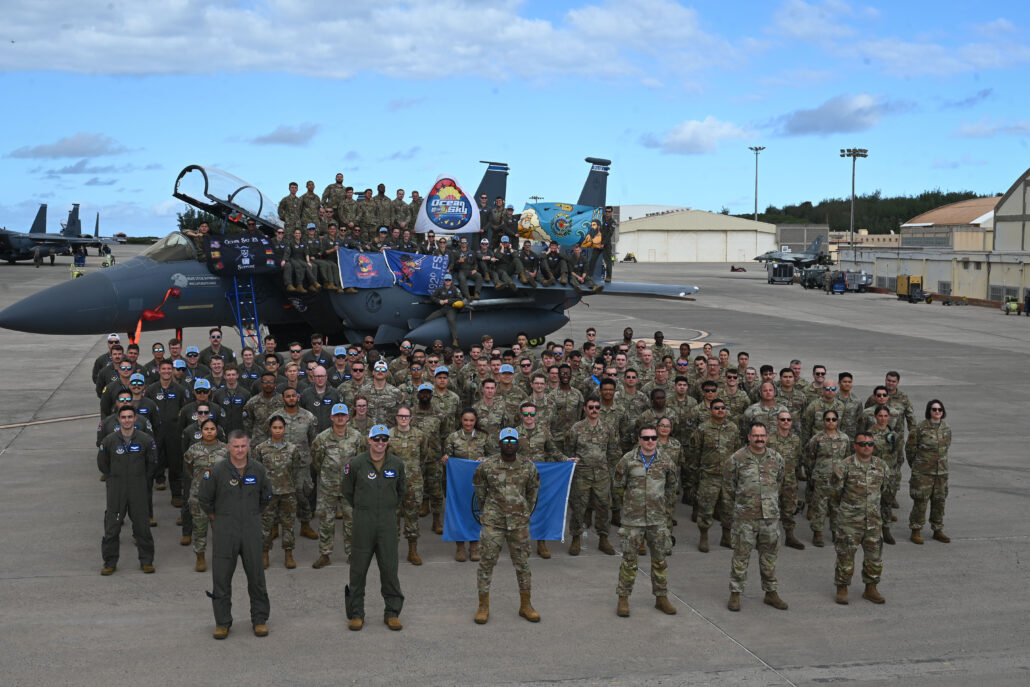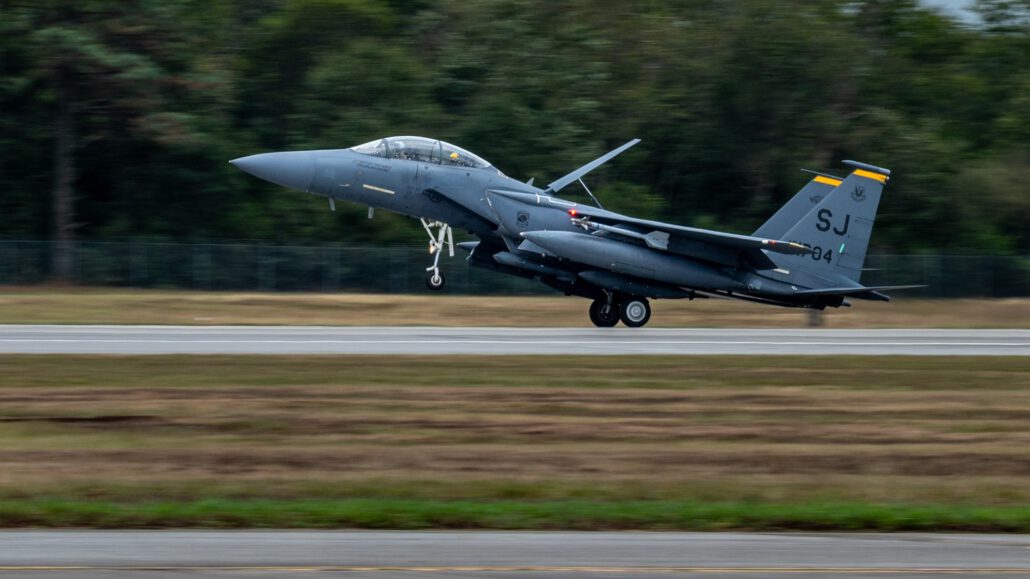Story by Maj. Wayne Clyne
KLAMATH FALLS, Ore. – The Oregon Air National Guard’s 173rd Fighter Wing made history Thursday, Sept. 26, 2025, as it graduated the last three F-15C Eagle fighter pilots before transitioning to the F-35 Lightning II. The graduation marked the end of a decades-long training mission that has produced some of the nation’s most skilled fighter pilots.Lt. Col. Tom McGee, commander of the 114th Fighter Squadron – the formal training unit for the F-15C Eagle – presided over the final class at Kingsley Field. The unit is scheduled to stand down its F-15C fighter training mission on Sept. 30, just four days after this historic ceremony.”These are the last three,” McGee said earlier, referring to the basic course students who represent the final graduates from one of only a handful of Air National Guard units entrusted with training both active duty and Guard pilots.
A Rare and Critical Mission
What sets the Oregon Air National Guard apart is its unique training mission. Unlike most Guard units that maintain operational readiness for their own pilots, the 114th Fighter Squadron trains pilots who will deploy to units across the country and around the world.
The three graduating pilots from Class 25-ZBK/YBK are 1st Lt. Jared Piubeni (who earned top academic honors), 1st Lt. Dustin Kopp (who earned Top Gun for excellence in tactics and airmanship), and 1st Lt. Aaron Zedella. They hail from Guard units in Portland, Oregon; New Orleans, Louisiana; and Barnes, Massachusetts – representing the remaining F-15C squadrons before their own transitions to newer aircraft.
McGee emphasized the weight of responsibility the Oregon Guard has carried: “The active duty Air Force counts on you guys to train the pilots. We’re good enough to turn out active Air Force fighter pilots that can go in and engage and destroy the enemy anywhere in the world with any adversary.”
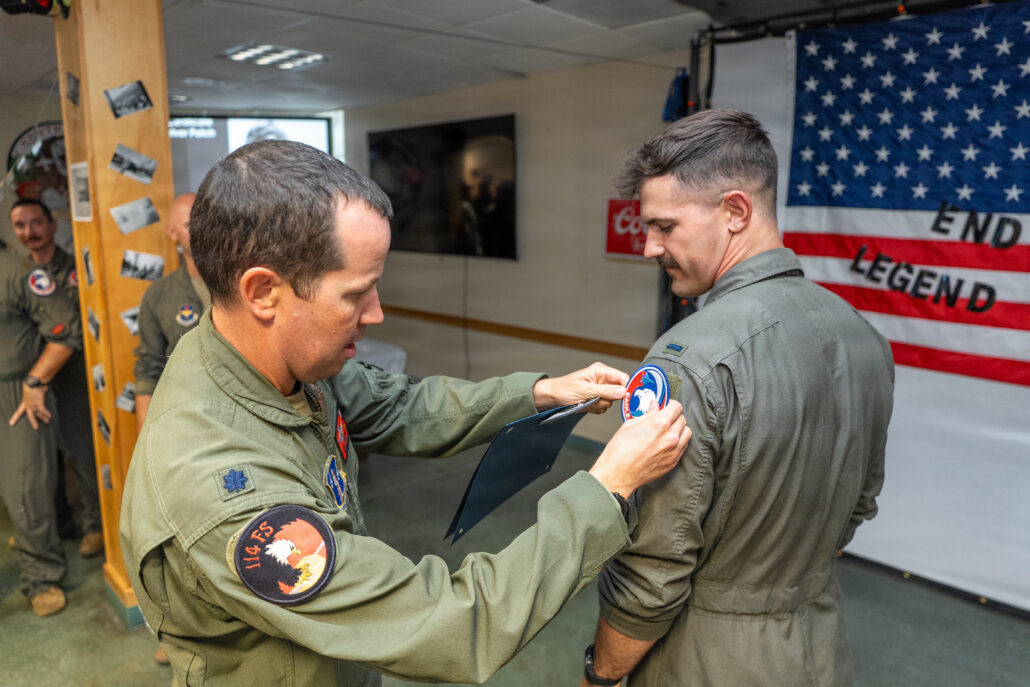
What Makes a Fighter Pilot
During the graduation ceremony, McGee delivered a powerful message to the new pilots about what it truly means to be a fighter pilot—a message drawn from years of mentorship and experience.
“Being a fighter pilot has nothing to do with the model of aircraft that you fly,” McGee told the graduates. “It is an attitude and determination to do your best at whatever you’re presented, whether it’s a close air support mission, whether it’s getting ready for the next deployment – you’re going to figure out how to crush it every single day.”
McGee emphasized that fighter pilots must rise to meet challenges independently. “No one’s going to solve your problems for you. You’re going to solve them yourself,” he said. “You’re going to be given problems where future commanders will say, ‘I have this problem for you,’ but they’re not going to tell you how to fix it.”
He reminded the graduates of the oath they took: “A fighter pilot does not accept a job from an employer. They swear an oath to the service of their country, and the fighter pilot makes a commitment to their squadron and its mission.”
Eagle Driver Heritage
The F-15 Eagle has served as an air superiority fighter since its first flight on Jul. 27, 1972. With an unmatched combat record of 104 kills and zero losses, the Eagle has proven itself across multiple conflicts, including Operation Opera (Israel), the Lebanon War, Operation Mole Cricket 19 (Israel), Operation Desert Storm, Northern/Southern Watch, Operation Allied Force, Operation Iraqi Freedom, and ongoing on-call air superiority missions.
McGee spoke about the significance of the Eagle Driver patch – the red, white, and blue insignia now worn on his left shoulder. “I think it’s probably one of the most famous ones,” he said. “But the only way you ever get the right to wear this patch is if you graduate from the B-course. It takes some time, and you’d better wear it every single day while you’re still here.”
Looking to the future, McGee acknowledged that the graduates would move on to different aircraft, with F-15EX and F-35 platforms on the horizon. “When you go off to fly the F-15EX, and you go to be an F-35 guy, you’ll be an F-35 guy,” he said. “But there’s a certain level behind you in your background that is never going to leave you, and that’s going to be you’re an Eagle Driver. People are going to know that based on your attitude.”
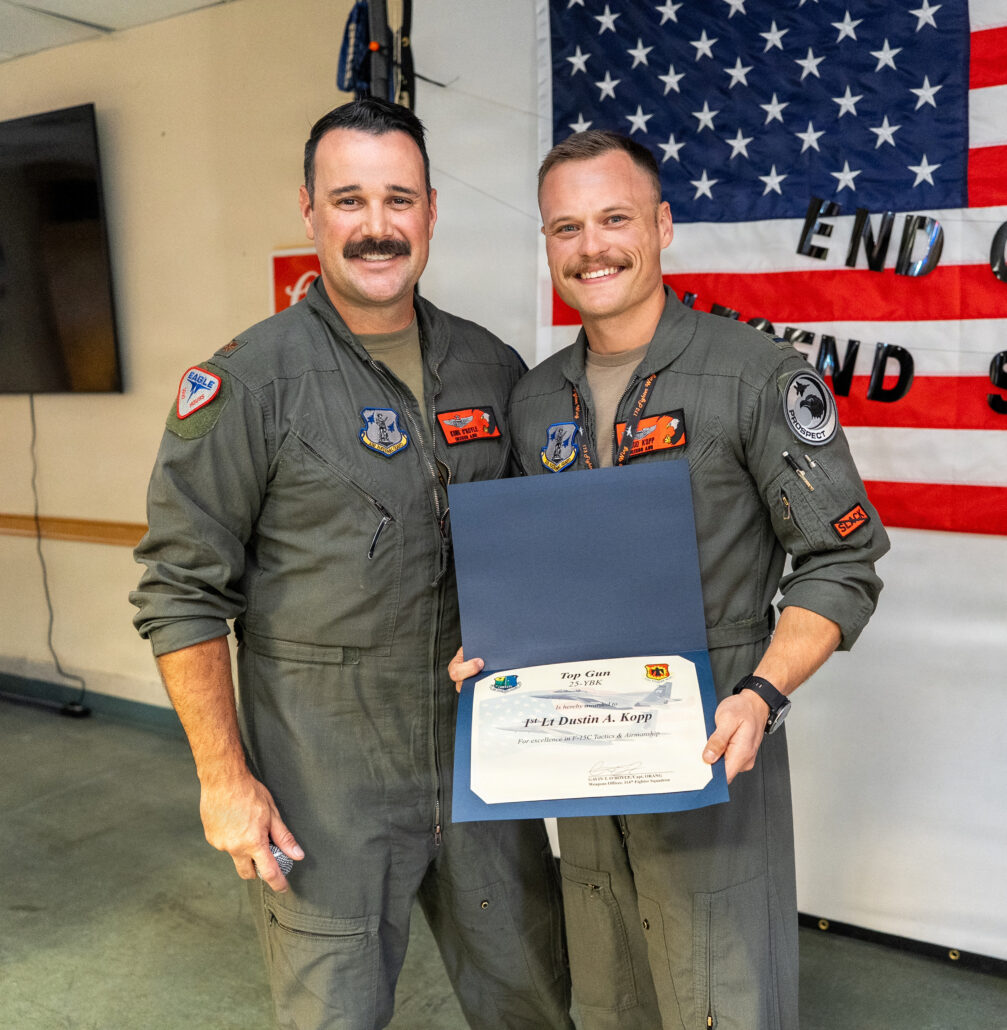
The Most Rigorous Training in the Air Force
The F-15C B-Course at the 173rd Fighter Wing is recognized as the most robust formal training course in the U.S. Air Force. The curriculum includes 295 academic hours, 32 exams, 41 programmed simulator events, and 42 syllabus sorties. Students complete an average of 15 aerial refuelings and fly missions including 14 Basic Fighter Maneuvers, 6 Air Combat Maneuvers, and 10 Beyond Visual Range engagements.
The training day runs from 6:30 a.m. to well past 4:30 p.m., every single day. Students must master single-seat mentality in a high-G, high-threat environment. The wing entrusts them with aircraft worth more than $40 million and sorties costing $40,000 per hour – not to mention their own lives and the lives of their instructors.
While the standard course typically runs seven to eight months, the final two classes were compressed into just five months – a testament to both the urgency of the mission and the capabilities of the students. “It was a pretty high-pressure cooker,” McGee explained in an earlier interview. “It’s one of the hardest F-15 courses you can go to.”
The F-15C Eagle, despite being an older airframe, remains in service due to its exceptional performance characteristics. “The only limitation in an Eagle is the pilot, not the airframe,” McGee said. “It looks strikingly similar to the airplanes that were in Desert Storm. But it didn’t need to be changed that much because it was created back in the day to take out Russian bombers – high speed, so it can go fast and go high, and turn really well.”
The Eagle can pull nine Gs and reach 50,000 feet – capabilities McGee noted with pride during the ceremony, comparing them favorably to “lesser fighters out there that aren’t nearly as cool, with only one tail or one engine.”
A Shrinking Mission
The drawdown of the F-15C training mission reflects broader changes across the Air Force and Air National Guard. In previous years, class sizes ranged from four to eight students, supporting four full active duty squadrons and five Air National Guard squadrons flying the Eagle.
As units transition to the F-35, including Barnes and Jacksonville, and as overseas squadrons like Lakenheath in the United Kingdom and Kadena in Japan shift to newer platforms, the customer base for F-15C training has steadily declined.
Historic Aircraft Finding New Homes
The retirement of the F-15Cs at Kingsley Field also means finding new homes for these combat veterans. Aircraft number 114, which scored two kills during Desert Storm, has recently been flown to the Smithsonian in Washington, D.C. Another jet with distinctive invasion stripes is also hoped to join a museum.
The majority of the remaining aircraft will be flown to Davis-Monthan Air Force Base in Arizona over the next three months, where they’ll be preserved in the desert climate for potential future use or parts.
A Legacy That Continues
McGee concluded the ceremony by thanking the families of the graduates and emphasizing that the connection to Kingsley Field doesn’t end at graduation.
“There’s absolutely no way that they would have ever gotten to this point if it wasn’t for all of you,” he told the assembled families and wing personnel. “When you leave here, you’re never done being Kingsley guys. I still find out what B-course graduates from seven years ago are doing, whether they’re deploying, whether they’re going to Weapons Instructor Course, doing great things.”
His final message to the last class carried both pride and responsibility: “Watch out. You have a reputation to carry with you as the last guys to graduate.”
The 114th Fighter Squadron operated as one of only three Air National Guard training units in the country. McGee acknowledged the unique position the Oregon Air National Guard occupied: “We kind of live in three different worlds at one time. We have three different bosses.” The unit produces pilots for Air Combat Command, Pacific Air Forces, and U.S. Air Forces in Europe while being part of the Air National Guard, which is not traditionally a training command.
As the 114th Fighter Squadron prepares to transition to the F-35, this final graduation on Sept. 26 represents not just the end of an aircraft era, but the culmination of a proud legacy of training excellence that has helped maintain America’s air superiority for decades. The Eagle Drivers who graduated that day carry forward a tradition of excellence that will continue, regardless of which aircraft they fly.
